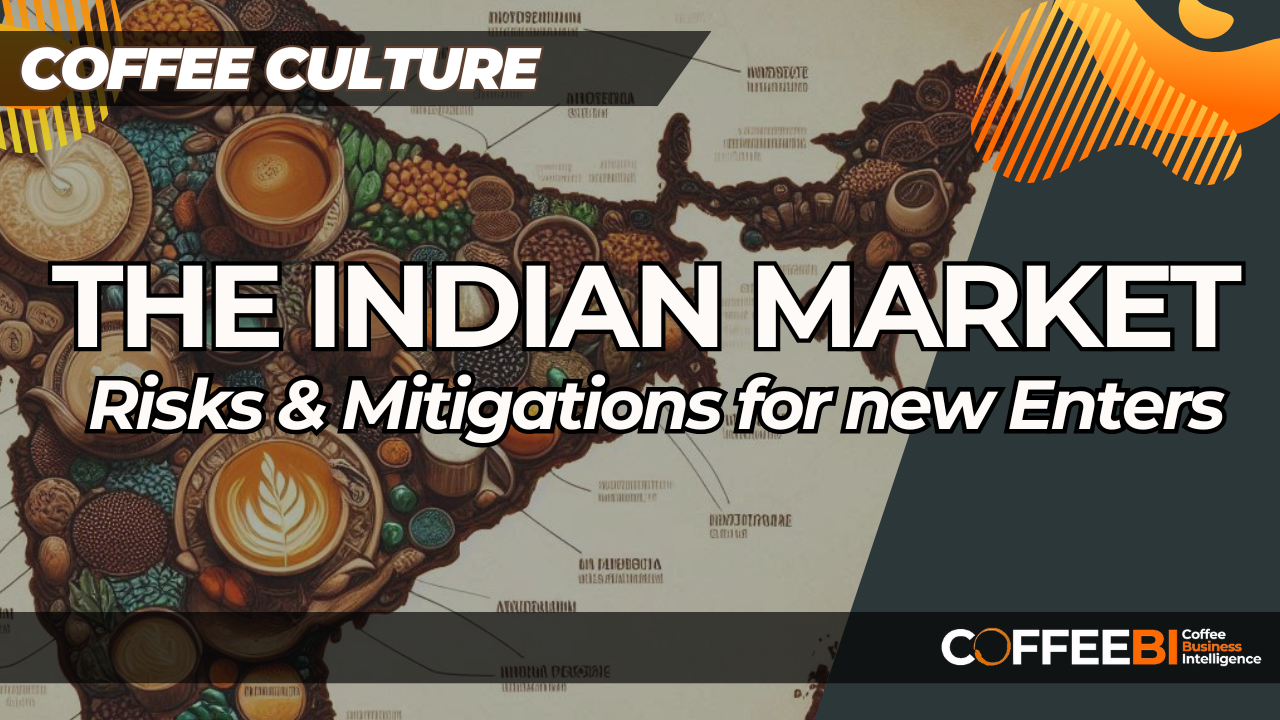Indian Coffee Market: Risks and Mitigations for New Entrants
The coffee market in India has several potential hurdles and pitfalls facing firms looking to enter or expand. We conducted a risk analysis and how to mitigate them for operators who want to enter the coffee market. Here below some insights:
Indian laws

One of the main challenges is the complex regulatory environment. You may take 6-12 months to enter the Indian market if costs for compliance requirements (which form 5-10% of operational expenses) are not met: meeting multiple regulatory bodies as well as compliance requirements in India is both time-consuming and costly. This barrier can be reduced by partnering with local consultants who have good knowledge of Indian regulations.
Strict land acquisition rules, especially for external firms, may slowdown the setting up of production facilities by between one and two years with land costs in coffee growing areas going up by 50-70% over the past five years. One possible solution for this issue could be entering into partnership agreements with locals who own vast tracts of land.
In addition, intellectual property protection could represent another issue; its enforcement has been limited and fake products constitute around 5-8%. Therefore, it’s important to undertake effective IP registration procedures as well as engage in proactive monitoring potential infringements.
India’s labour laws are complex and sometimes rigid. This makes it difficult to put in place flexible workforce models. In the organized sector, labour costs increase by 8-10% annually. To deal with this challenge can involve investing in automations where possible and developing strong HR policies that are not rigid.
Costs and distribution
Foreign exchange fluctuations can lead to profit risks, where Indian Rupee has an annual volatility range from 5-10%. Hedging strategies implementation as well as increasing local procurement can contribute towards reducing this kind of risk thereby increasing profitability.
Higher distribution costs and product spoilage may arise from infrastructure limitations such as underdeveloped cold chain and logistics facilities in many areas, where average distribution costs are reported to be 15-20% higher than those in developed economies and losses could range between 5-8% depending on location. This risk can however be managed by partnering with specialized local logistics providers.
There is also a distinguished obstacle that comes from established local competition. New entries cannot easily capture substantial market share due to strong local brands having an extensive knowledge of the market. The first year normally sees less than two percent market shares for new entrants while marketing costs could be higher by 20-30% compared with mature markets. Concentrating on segment niches or innovations that are not catered for by current players can be a successful approach for your company.
With uneven development across the country, digital infrastructure gaps pose a challenge. Initially, local sourcing requirements may increase sourcing costs by 10-15% and restrict product range quality. However, overcoming these barriers might involve gradually developing a local supplier base and exploring opportunities for investing in local production facilities over time, rather than all at once. A phased, region-specific entry strategy should help in managing these costs for firms that want to operate in India. A good advice is always maintaining good relationships with local authorities while also diversifying political risk across regions for mitigation purposes.
Indian consumers
Indian consumers’ perception of prices, especially in the general public market segment, is yet another important factor. The rich people’s products are most times attractive to only 10% of urban residents who have their prices cut by either 30-40 percent when compared to Western markets with similar type of products. This can be overcome by designing India specific product lines or modifying existing ones to match local price points.
There still exists a cultural challenge since India’s strong tea drinking culture means an average coffee consumption per capita of only 0.2 kg/year comparing to Western Europe’s 4 kg/year. When it comes to marketing costs for consumer education, they might go up by almost 25-30% compared to those operating within well-established coffee markets. Businesses can target young population groups as well as urbanized areas where coffee culture is gaining popularity in order to enter the market. For example, multiple marketing and distribution strategies have to be used due to regional diversity in consumer preferences and business practices across different states thereby increasing operational cost of approximately 15-20%.
Climate change and local issues
Additionally, climate change is another major risk with rising temperatures and changing rainfall patterns impacting coffee farming causing a 15-20% variation in output and affecting the quality of 10-15% of harvested crops. These consequences can be mitigated by diversifying sourcing regions and investing in germplasm that is better able to withstand varying climates.
The long-term risk of water scarcity is looming large over some coffee growing areas. One way around could be investment in water-efficient processing technologies as well as supporting watershed management projects. If this happens, then there will be policy uncertainties hence delaying investment decisions by 6-12 months due to political instability or potential policy changes could result into a delayed investment decision period (6 – 12 months).
Ready to enter the Indian coffee market?
Get 10 essential points you need to know for entering the Indian coffee market and succeeding.



